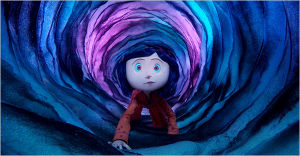
My friend Nancy O. Graham reviewed the new Henry Selick 's Coraline, on her blog oswegatchie and Alternative Films for Kids. The film opens today at the Park Slope Pavilion at 2:00, 4:25, 7 and 9:40.
Here's an excerpt from Nancy's review:
My son Ray has been making movies since he was six: stop motion animation, live action, and lately, CGI parodies of Star Wars.
He reads film production books and bios of animators like Chuck Jones,
and loves ‘making-of’ bonus features and little biopics about revered
figures like Ray Harryhausen. One of his ‘mentors’ is Henry Selick, who
has just completed his adaptation (for 3D stop-motion animation) of
Neil Gaiman’s novel, Coraline.
It was our enormous good fortune—mine, my son’s, my daughter’s, my husband’s, and his mother’s—to visit the set of Coraline
a couple of years ago, and a real treat to see a preview screening of
the finished work the other night in Manhattan, with Henry Selick on
hand to answer audience questions.
Ray,
who is 11, wasn’t sure he wanted to see what he called a ‘horror’
movie. His 9-year-old sister, who acts in most of his movies and in her
own monologue-driven shorts, was firm: she wouldn’t go to the
screening. The monstrous Other Mother of the previews, and the prospect
of having her lunge from the screen, were horrors they could live
without.
So, Ray and I headed into NYC with the plan that he
would shut his eyes, pull his jacket up over his face, and hold his
hands to his ears if it all got to be too much. He was willing to
endure, if only for the Q&A portion of the evening.
As it turns out, he didn’t have to worry too much. He only shut his eyes once, and not for long. While the idea of Coraline
is truly terrifying—a girl is left alone to rescue her supernaturally
abducted parents—its creators have allowed the idea to carry most of
the weight of emotion, as with the best fairy tales, and haven’t piled
onto it with 3D shock effects or long, anxiety-provoking suspense
sequences. The Nightmare Before Christmas, with its cast of
characters in varying states of decomposition, is more horrific—at
least to me, and I think my son, who got to an age where he felt too
uneasy to watch it, and wouldn’t go near the undead-dominated Corpse Bride, would agree.
Henry
Selick has done a beautiful job of reconceptualizing the novel for the
screen and for stop motion. From the first moments, when metal hands
sew up a doll-sized version of the title character and cast her into a
void, this is a movie that invites contemplation of the animator and
the animator’s art. Our first view of the hands of the evil Other
Mother, creator and destroyer of the Other World, are bare of fleshly
trappings, primordial armature. We come to find that the energy of
children is what makes the Other Mother’s material other world, and it
is their life force that makes it beautiful, whimsical, and inviting.
If you have watched any of the featurettes about Coraline,
you have seen artist after artist toiling and tinkering away, as
artists always do on these projects, though now, with the Internet, in
less obscurity. They can even blog about their work for Laika Studios.
It’s hard to watch that image of armature hands making the Coraline
doll and not think of all the human hands that have gone into the
making of this supremely hand-made movie, and seeing in these moments a
tribute to them all (certainly they deserve a tribute, including those
several dozen Laika workers, I was sorry to read, who were recently
laid off).
OtherMotherWorld is especially fanciful and so packed
with detail it's hard to imagine not seeing the movie many times to try
to take it all in. Henry S. has ensured that the Other Mother’s
overture to Coraline is suitably seductive. She—and we—are truly
tempted to stay and sample more delights from the animators’ cabinet of
wonders. The wonders really are wonderful; we laughed throughout the
early other world scenes. In the post-screening Q&A, Henry S.
talked a bit about his motivation for shooting in 3D. He wanted the
audience to have more access to the animators' world—2D doesn't really
allow it. So the other world—more colorful, more fanciful—really is the
animators' world. (One could imagine a version that is flat when we're
in Coraline's world and 3D only in the other world, like the sepia vs.
color worlds of The Wizard of Oz.)
